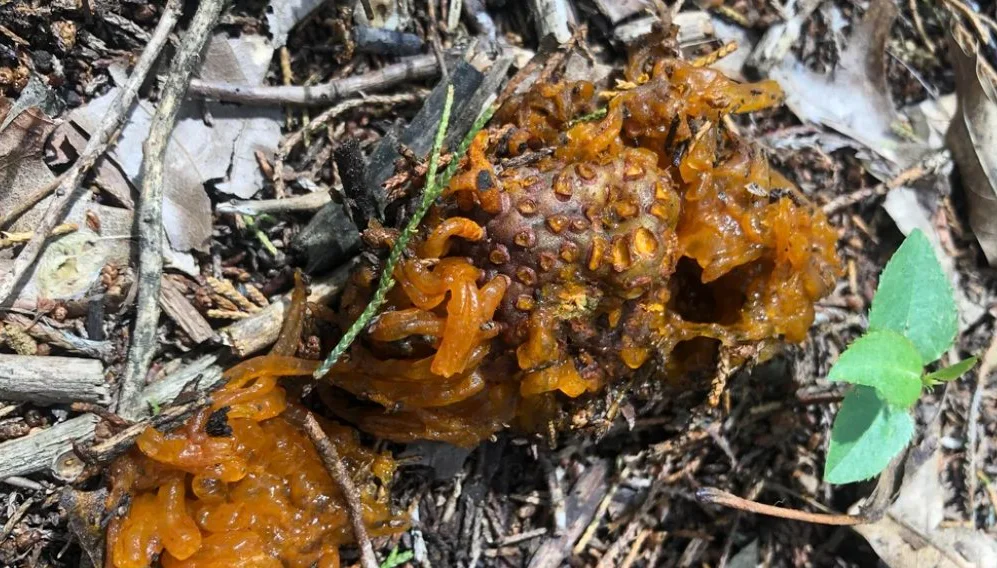
Owning a garden and caring for your plants requires an understanding of potential issues that may arise. If you come across a mysterious substance known as the “jelly nut” in your garden, here’s what you need to know.
Recently, a Redditor from Oklahoma discovered an odd sight in his garden, bright “yellow goo” on his trees and a peculiar object he described as a “gelatinous alien nut”. Unsure of what it was, he turned to the Reddit community for assistance, mentioning that the affected tree was a conifer, though he couldn’t identify it further.
Almost immediately, another user identified the problem as “cedar and apple rust”. This disease depends on two host plants to complete its life cycle, primarily affecting apple and crabapple trees.

The symptoms vary depending on the type of tree. On junipers, a brown gall forms on twigs and produces orange, gelatinous horns in the spring, particularly during wet weather. Although the twig beyond the gall may die, the damage to the juniper is minimal.
For apple and crabapple trees, yellow circular spots appear on the leaves soon after flowering. By late summer, brown clusters of cylindrical structures develop underneath the leaf spots, on twigs, or even fruit.
Galls from the infection can take several months to develop, appearing around seven months after infection begins. After 18 months, they evolve into gelatinous masses. In the spring, these galls develop depressions resembling golf balls, which give rise to telial horns that elongate and turn bright orange during rainy periods. After releasing spores, these horns collapse and dry up, although the galls can remain attached to the tree for another year.

Management of this infection can include pruning the affected areas or simply allowing it to run its course since it typically doesn’t kill trees but may cause some disfigurement. Preventive measures, such as fungicides or planting resistant apple varieties, can also help.
Overall, while cedar and apple rust isn’t a severe threat to your trees, being informed about it allows you to take the right steps if it appears in your garden. Share this information with others so they can be prepared too!
Came Back from Vacation to Find a Stranger Living in My House — He Refused to Leave, So I Took Matters into My Own Handsnew 758

Returning from a blissful Hawaiian vacation, Lisa and her two young children were shocked to find an unwelcome guest comfortably settled in their home. Faced with an uncooperative squatter and little help from the police, Lisa was forced to take drastic measures to reclaim her family’s sanctuary.

A woman and her two children | Source: Midjourney
Hi everyone, I’m Lisa, a 38-year-old single mom of two wonderful kids. There’s Ethan, my energetic 8-year-old son, and Chloe, my thoughtful 10-year-old daughter. We just got back from a dream vacation in Hawaii. It was supposed to be a relaxing break, but what happened when we came home was anything but relaxing.
We’d been looking forward to this trip to Hawaii for months. Chloe had made a whole list of things she wanted to do, and Ethan couldn’t wait to see the volcanoes. I needed this break as much as they did. It had been a tough year, and a week in paradise seemed like the perfect escape.

A tired woman dreaming about her vacation | Source: Midjourney
Before we left, I made sure everything was set at home. I asked my sister, Emily, to take care of our dogs, Luna and Max. She loves them almost as much as we do, and I knew they were in good hands.
Emily was thrilled to help. “Don’t worry about a thing, Lisa. I’ll take good care of Luna and Max. You just enjoy your vacation.”

A woman with her two dogs | Source: Midjourney
“Thanks, Emily. I really appreciate it,” I said, feeling a bit lighter knowing the dogs were in good hands.
A couple of days into our trip, Emily called me.
“Hey, Lisa, can my friend Mark stay at your place for a night? He’s in a bit of a tough spot.”
I hesitated. “Just for one night?”

A woman calling her sister | Source: Midjourney
“Yeah, just one night. I promise.”
“Okay, but only one night,” I agreed, thinking it would be fine.
Hawaii was everything we had hoped for. We hiked through lush forests, swam in the crystal-clear ocean, and even took a helicopter ride over a volcano. Chloe was in awe of the sea turtles, and Ethan couldn’t get enough of the pineapple smoothies. It was a perfect getaway, and for a moment, all our worries seemed to melt away under the Hawaiian sun.

Palm trees during sunset | Source: Pexels
We got back from Hawaii on a sunny afternoon. The kids were exhausted but happy. As soon as we walked in, I felt something was off. The house was too quiet. Usually, Luna and Max would be at the door, tails wagging. Now, they were sitting behind the couch, terrified.
“Stay here with your brother,” I told Chloe, my heart pounding. “I need to check something upstairs.”

A scared woman in her home | Source: Midjourney
I climbed the stairs, my anxiety growing with each step. When I got to my bedroom, I couldn’t believe my eyes. There was Mark, sprawled out on my bed, with his things all over the place.
“What are you doing here?” I demanded.
He looked up lazily. “Oh, hey, Lisa. I just needed to stay a bit longer. I’m job hunting in LA.”

A man in his trashed room | Source: Midjourney
“That wasn’t the deal,” I said, trying to keep my voice steady. “You need to leave. Now.”
He didn’t even flinch. “I need another week. Emily said it’d be okay.”
“No, it’s not okay. Get out,” I insisted.
He just shrugged and went back to his laptop. I couldn’t believe it. I stormed downstairs, my heart racing.

A man working on his laptop in his bed | Source: Midjourney
“Mom, what’s wrong?” Chloe asked, her eyes wide with concern.
I called the police, thinking they’d help me get Mark out. When they arrived, I felt a glimmer of hope.
“Thank goodness you’re here,” I said. “There’s a man in my house who won’t leave.”
One of the officers nodded. “Let’s talk to him.”

The police sirens | Source: Pexels
We all went upstairs, and the officer spoke to Mark. He calmly explained that he needed more time and had nowhere else to go.
“Ma’am, this is a civil matter,” the officer told me. “You’ll need to go through the eviction process.”
“Eviction process? But he’s only been here a few days!” I was shocked and frustrated.
“I’m sorry, ma’am. There’s nothing we can do right now.”
I felt my stomach drop. “So he just gets to stay here?”

A shocked blonde woman talking to a policeman | Source: Midjourney
“Legally, yes. You’ll need to file for eviction.”
The officers left, and I was fuming. This wasn’t how it was supposed to go. I had two kids and a house to protect. I couldn’t let this stranger stay here any longer. I went back downstairs, trying to stay calm for Ethan and Chloe.
“Is everything okay, Mom?” Chloe asked.
“No, sweetheart,” I sighed. “But I’m going to fix it. Don’t worry.”

A mother and her daughter on their front porch | Source: Midjourney
Ethan tugged at my sleeve. “Can we still play outside?”
I forced a smile. “Of course, buddy. Just stay in the backyard where I can see you.”
As they went outside, I took a deep breath, trying to calm my racing heart. I knew I had to come up with a plan, and fast. There was no way I was letting Mark stay in my house another day.

A child running | Source: Pexels
After watching my kids play for some time, I called Emily. She felt awful and apologized repeatedly.
“Lisa, I’m so sorry. I had no idea he’d pull something like this,” she said, her voice full of guilt.
“It’s not your fault, Emily. But we need to get him out. I can’t let him stay here any longer.”
“Let’s think this through,” she replied. “We need a plan that won’t get us in trouble.”

A woman talking on her phone in her living room | Source: Midjourney
We brainstormed ideas and finally came up with a solution. We would wait until Mark left the house, then pack his belongings and leave them outside. We’d lock all the doors and refuse to let him back in. It wasn’t ideal, but it was the best we could do without breaking the law.
“Are you sure this will work?” Emily asked, sounding unsure.
“It has to. I can’t have him here another day,” I said firmly.

A woman talking to her sister on her phone in her living room | Source: Midjourney
The next evening, I watched from the window as Mark left to grab dinner. Emily arrived, and we wasted no time.
“Let’s do this quickly,” I said, trying to stay calm.
We hurried upstairs and started packing his things. Clothes, laptop, toiletries—we stuffed everything into his bags. My heart was pounding, and I could see Emily was just as nervous.
“What if he comes back early?” she whispered.

A blonde woman packing a bag | Source: Midjourney
“We’ll deal with it. Just keep packing,” I replied.
We finished in record time and dragged his bags to the front porch. We locked the doors and windows, then sat down to wait.
Two hours later, Mark returned. I watched from the window as he approached the porch, saw his bags, and realized what had happened. He started pounding on the door, shouting.

An angry young man on the porch | Source: Midjourney
“Open the door! You can’t do this!” he yelled.
I took a deep breath and opened the window just a crack. “You need to leave, Mark. Your things are outside. This is my house.”
“You can’t kick me out! I have rights!” he screamed.
“You were only supposed to stay one night. You’ve overstayed your welcome. Leave now, or I’ll call the police again,” I said, trying to sound firm.

A woman screaming in her living room | Source: Midjourney
Mark wasn’t backing down. He pulled out his phone and called the police. I could hear him ranting about being locked out of the house. A short while later, a different set of officers arrived.
“What seems to be the problem here?” one of them asked.
“She locked me out! I have nowhere to go!” Mark exclaimed.
The officer turned to me. “Ma’am, can you explain what’s going on?”

A police officer | Source: Pexels
I explained everything from the beginning, emphasizing that Mark was only supposed to stay one night. The officer listened carefully, then turned back to Mark.
“Do you have any proof that she gave you permission to stay longer?” he asked.
Mark fumbled, trying to come up with an excuse. “It was verbal. I don’t have it in writing. There might have been a message, but I think I deleted it accidentally.”
“Can I see your ID, sir?” the officer asked.

A bewildered young man | Source: Pexels
Mark handed over his ID, and the officer radioed in to check his background. A moment later, the officer’s expression changed.
“Sir, you have an outstanding warrant for a shoplifting charge. I’m afraid we’ll have to take you in.”
Mark’s face went pale. “What? No, this is a mistake!”
The officer cuffed him and led him to the patrol car. “Ma’am, we’ll handle this from here. He won’t be coming back.”

A policeman arresting a man | Source: Pexels
As the police drove away with Mark, I felt a huge weight lift off my shoulders. I turned to Emily, who looked equally relieved.
“We did it,” I said, finally able to smile.
“Yeah, we did. I’m so sorry for all this, Lisa.”
“It’s okay, Emily. It’s over now.”

Two women hugging | Source: Pexels
When I told Ethan and Chloe, they were happy to hear that everything was back to normal. Chloe gave me a big hug. “I’m glad he’s gone, Mom.”
“Me too, sweetie,” I said, feeling a surge of relief.
That night, we slept peacefully, knowing our home was safe again. We had faced a nightmare, but we came out stronger. Our home was truly ours once more.



Leave a Reply